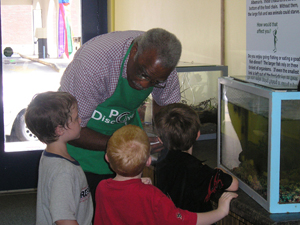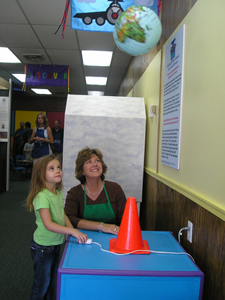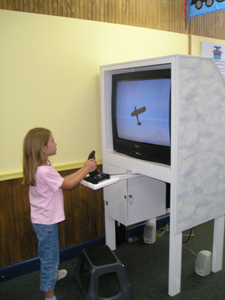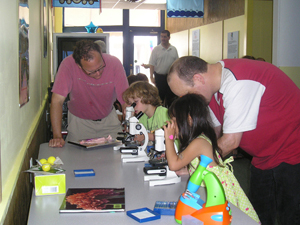 Port Discover Science Center |
Science in my first life. The Port Discover Science Center located in downtown Elizabeth City provides me with my most rewarding philanthropic exersizes and volunteer activities.
The center runs on a shoe-strig budget of a little over $50k a year. With that it must rent a space in a downtown location, pay for electric and DSL service, and a Science Education Specialist.
Port Discover is the brainchild of LuAnne Pendergraft, who has a fantastic background in grant-writing and museum studies. Her husband, Don Pendergraft, is the Exhibit Design Chief at the Museum of the Albemarle, Elizabeth City’s largest landmark.
Early on in building Port Discover, Luanne stressed the point that this is a science center not museum, emphasizing the importance of hand-on activities, interactions, and engagement. Science is an ongoing process of exploration and discovery. The center needed to be a playground, not an exhibit.
 Dr. Pringle with Aquarium Displays |
LuAnne geared the center’s exhibits toward the local community. This meant focusing on the local environment, marine and marshland, and aviation, because of the Coast Guard airbase which employs most people in the area.
Dr. Pringle, a Marine Biology Professor from ECSU, donated and maintains two aquariums from his department. One is filled with sea anemones, starfish, and other salt-water animals. The other is filled with local unusual plant life, which is equally fascinating. Nothing captures the imagination like a venus fly trap.
Billy Younger, Professor of Astronomy at the College of the Albemarle, brought in an old satelite dish, which he painted the stars and constellations on in their positions in the night sky as they were on the center’s opening date. The dome creates an interesting acoustical effect when you stand under it and speak as well.
I recently learned that Billy has been putting on a one-man science show, which includes laying down on a bed of nails and having someone break a cinderblock on his chest with a sledgehammer. He also freezes a rose in liquid nitrogen and shatters it to gasp of amazement from his young audiences.
Museum Designer Morgan Kenny helped to give the center that official look and feel. He also put together a wooden bit of architecture to hang over the center’s administrative area based on the Golden Mean.
Another benefactor donated an entire cabinet of sea shells, an incredible collection. So it’s like having a real life Cabinet of Curiosities to play with.
 Bernoulli Blower |
I volunteered to construct the Bernoulli Blower, which demonstrates the principle of lift using a jetstream of air and objects to “levitate” in its current.
My advice to anyone wanting to build a bernoulli blower: Don’t buy an army surplus fan or a high velocity fan or a ventilation fan. Save yourself a whole lot of grief and buy the cheapest electrical leafblower you can find.
After finding a suitable blower, the next most difficult step was building a kid-proof wooden box to house the thing in. A simple safety cone allows redirecting the airstream and mutes the sound slightly. Foam insulation glued inside the box also helps to dampen the noise, and holes drilled around the base allow air to flow into the box.
We’ve been having trouble with the light-dimmer switch I set up to let kids play with variable blower speeds. The leafblower requires far more electricity than the dimmer-switch can handle (go figure, it’s made for lamp-lights), and we’ve been burning through one dimmer-switch every two months on average. One solution I’m looking forward to, a volunteer intends to donate a veriac transformer for the display, which will not only let the kids play with differen wind settings, but see how much electricity is being channeled through the blower as well. Nifty!
 Flight Simulator |
What’s the easiest way to increase the number of displays in a limited space? One word: Computers!!! Google Earth, Re-mission, and other science softwares. Not to mention the World Wide Web is brimming with cool flash games like Pandemic and Climate Challenge and Mouse Party.
Microsoft Flight Simulator “A Century of Flight” provided a great interactive display. A control stick, television, and computer tucked away in a cabinet make for a fairly low-maintenance display. A volunteer from the Elizabeth City Rotary club built the display, which totally rocks. The display would have fallen forward to crush some poor child if I had built it.
I was able to set up the simulator to fly out of the Elizabeth City Coast Guard base, allowing children to fly over the city, which isn’t rendered in detail, but there are enough landmarks to make it interesting.
My sister, Rachelle, designed the website, which looks fantastic and is generously maintained by Tamera Phillips of Blufish Design Studio.
 Microscopes Rule All |
A digital projector and theater surround-sound system I set up in the space don’t get the use I’d hoped they would, but that has a lot to do with the cramped quarters. A larger space, with lots of seating could take advantage of this entertainment center and the small library of DVD documentaries I’ve provided for it.
Then there are the dreams I’ve got for the space if only I had the money and time. I would love to get ten-plus laptops with wifi and have virtual field trips to science displays in second Life. Maybe someday when I’ve got $10k to part with.
Luanne has put an amazing amount of effort into Port Discover’s success, and it has definately paid off. Whenever I’m in the Center to maintain the computers, I see waves of children coming in to play with the various exhibits. Thanks to Mrs. Pendergraft, I think it’s fair to say, the small town of Elizabeth City has more Science Culture than many real cities.